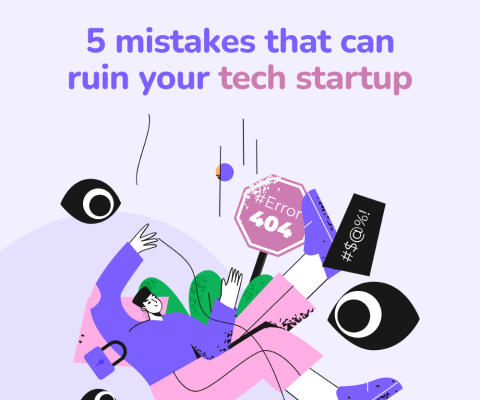December 4th, 2025, posted in for_founders
by Adelina
Over the past decade, the term MVP has traveled far from what it was meant to describe. What started as a simple idea for learning quickly turned into a buzzword that often gets misused in product discussions. Teams say, “Let’s just build a minimum viable product” as if it guarantees speed, clarity, and a successful product launch. But more often, it becomes the reason a project feels rushed, confusing, or directionless.
The real issue is not the MVP itself, but how it is understood. Many teams think that to create an MVP means the cheapest version of a product, something half-built or stripped down to the point where it no longer shows value. Others assume that if they launch something minimal, users will somehow magically understand the vision and get excited about what is coming next.
In reality, most MVPs fail not because they are small, but because they lack purpose. They are built without clarity on what needs to be learned, without real understanding of user needs, and without meaningful ways to measure success. When an MVP is just a quick build with no direction, it creates more confusion than insight.
So the question is not “Should we launch an MVP?”
The real question is: When does building your MVP actually make sense, and when does it slow you down?
That is what we will explore.
What an MVP Was Originally Meant to Be
The minimum viable product wasn’t designed to be a shortcut to launching a product quickly or cheaply. Its roots come from the Lean Startup framework, where the goal is to validate assumptions through learning, not to put a half-finished product in users’ hands. The idea was simple: build and launch the smallest, most focused version of your solution that allows you to test whether a key assumption is true.
That could be an interactive prototype, a concierge service, a landing page with a sign-up form, or yes, sometimes a very small product. The format doesn’t matter. What matters is that it answers a question.
The MVP is not the “first draft” of your final product. It is not a slimmed-down version of your full feature set. It is not something you build to tick a milestone or satisfy a board meeting. It is an experiment designed to reduce risk.
The real objective is to identify the riskiest assumption in your idea, whether that’s “people will use this,” “people will pay for this,” or “this solves a meaningful problem”, and then test it with the smallest real-world effort possible. If the test teaches you something valuable, the MVP succeeded. If it didn’t teach you anything, then it wasn’t an MVP. It was just a rushed release.
Why Most MVPs Fail Today
Despite the clarity of the original concept, many tryouts to develop an MVP fail, not because the idea is bad, but because the process is misunderstood.
Teams often start building too soon, driven more by enthusiasm than insight. A founder has a spark of inspiration, a designer jumps into Figma, and before anyone talks to real users, the development team is already estimating timelines. The problem hasn’t been validated, but the solution is already rolling forward.
Then comes the feature creep disguised as “minimum.” Someone realizes the product needs onboarding. Then analytics. Then notifications. Then user roles. Before long, the MVP is no longer minimal, it’s simply underbuilt.
Another common issue is that the MVP is designed to look impressive, often for investors or internal stakeholders, rather than to answer a meaningful question. It becomes a pitch artifact instead of a learning tool.
And even when something is launched, success is rarely defined upfront. Teams release the MVP, check the analytics dashboard, see some numbers go up or down, and still have no clarity on what those numbers mean. The lack of a clear hypothesis makes interpretation impossible.
So the product launches, the team receives little engagement, confusion follows, and the instinctive reaction is, “We need more features.” But the real problem is that the MVP was never built to test a specific assumption, so it couldn’t confirm or disprove anything.
When the goal of the MVP product is unclear, the outcome will be unclear too.
When Building an MVP Makes Sense
There are situations where building an MVP is absolutely the right strategic move. It makes the most sense when you’re exploring something new, a new product category, a new customer need, or a behavior you can’t fully predict yet. In those moments, the goal isn’t to be perfect, it’s to learn quickly.
If you have one clear core value proposition you can isolate, something you believe users will care about, an MVP becomes a way to test whether that value is real. You’re not trying to solve everything at once; you’re testing the beating heart of the idea.
And an MVP doesn’t have to be “a tiny version of your full product.” The format depends on what you’re trying to learn. Sometimes it’s just a landing page with a waitlist that tells you whether anyone is interested. Sometimes it’s a clickable prototype you walk through with real people to observe reactions. Other times, it’s a service you deliver manually behind the scenes, even though the interface appears automated, the classic Wizard-of-Oz approach.
Or maybe it is a small working product, but one that focuses only on the single, essential workflow that defines your value.
In all these scenarios, the MVP is a conversation starter with the market, not a launch. It’s an invitation for user feedback that helps you move from assumption to clarity.
When You Shouldn’t Build an MVP
However, the MVP approach is not right for every product or every stage.
If the problem you’re solving is already well-understood, for example, you’re entering an existing market or improving something people already use, you may not need to validate the problem. You already know the need exists. What you need instead is differentiation, quality, and reliability.
There are also product spaces where trust matters from day one. In fintech, healthcare, security, or enterprise software, a “minimal” or “rough” product won’t be interpreted as early-stage, it will be interpreted as unsafe, unprofessional, or risky. Here, an MVP can do more harm than good by damaging credibility before you even begin.
And for products where the user experience itself is the value, premium consumer apps, lifestyle brands, or tools where aesthetics and smoothness define perception, releasing something rough can set expectations in the wrong direction. Once a user forms a negative impression, it’s hard to reverse.
In these situations, building MVPs isn’t just unnecessary, but it can actively undermine the trust you need.
Alternatives to building an MVP
If the traditional MVP development process doesn't fit your context, there are smarter and lighter ways to learn before committing to develop your mvp.
One approach is concept testing, simply talking to real users before anything is built. Not surveys, not hypothetical opinions, but structured conversations that explore how people solve the problem today, what frustrates them, and what they value most. This alone can prevent months of building the wrong thing.
Another option is clickable prototypes. These look like real products but have no backend. They let you observe how users move through an experience, where they hesitate, and what they ignore. You learn about usability and value perception before writing a single line of code.
For more complex workflows, teams sometimes run manual or concierge tests. The interface stays simple, while real people perform the “automation” behind the scenes. It may feel scrappy, but it allows you to validate workflow logic, demand, and pricing before scaling.
And if you're improving an existing system, sometimes the best approach is rolling out one core feature at a time rather than releasing a brand-new product all at once. This reduces risk, preserves trust, and lets you refine with real usage data.
The real goal in all these approaches is the same: reduce uncertainty before committing resources.
How to Decide What to Build First
When deciding what to build, MVP or not, the starting point is always the same: clarity.
First, define the core user problem. Not the feature you want to build, not the roadmap item, but the underlying need or pain. If the problem is vague, the product will be too.
Next, identify the smallest meaningful solution that would allow someone to experience the intended value. Not the smallest UI, not the smallest codebase, the smallest version of the value itself.
Then consider who you’re building for. Some audiences will accept rough edges during early testing, others expect polish from day one. Level of finish matters.
Finally, choose how you will validate your assumptions, and remember that validation does not always require shipping software. Talking to users, prototyping, and staged rollouts are often faster and more informative than immediate mvp development.
A useful internal question to ask:
What are we trying to learn, and what is the simplest way to learn it?
If your answer requires writing code, great, but let that be a conclusion, not a default.
The MVP isn’t outdated, and it isn’t a bad idea. It’s simply misunderstood.
The point of a successful MVP was never to build quickly for the sake of speed. It was to learn quickly so you don’t waste time building the wrong thing.
The right approach depends on your target audience, your market, and how much is already known. There’s no one playbook.
But a good guiding principle is this: Build the smallest version that delivers real value, not just the smallest version you can ship.
When you focus on clarity, learning, and meaningful outcomes, you don’t just move faster, you move smarter.
Looking to build your MVP the right way? Contact us and let’s turn your product idea into something users actually love.

















